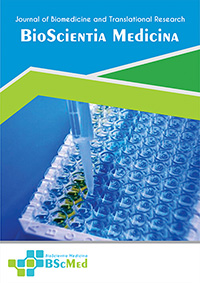Main Article Content
Abstract
Background: Medullary thyroid carcinoma (MTC) is a rare neuroendocrine malignancy accounting for 1-5% of thyroid cancers. While often presenting with cervical lymphadenopathy, distant metastasis to bone and soft tissue mimicking a primary sarcoma is exceptionally rare. This report details a case of MTC where the primary diagnostic challenge was a massive, destructive shoulder mass.
Case presentation: A 58-year-old woman presented with a disabling, 20 cm mass in her left shoulder, progressively enlarging over two years. The patient also noted a 30-year history of a stable, asymptomatic neck lump. Magnetic Resonance Imaging (MRI) revealed a large, hypervascular, destructive mass obliterating the scapula and invading surrounding musculature, with a radiological differential diagnosis of a primary soft tissue sarcoma. Laboratory investigation, however, revealed a massively elevated serum calcitonin (>2000 pg/mL) and carcinoembryonic antigen (CEA) (180 ng/mL). A CT-guided core biopsy of the shoulder mass, initially suspected to be a sarcoma, was negative for all sarcoma markers. Instead, it was strongly positive for neuroendocrine (Synaptophysin, Chromogranin A) and thyroid-specific (TTF-1, PAX-8) markers, as well as definitive MTC markers (Calcitonin, CEA). This confirmed the diagnosis of metastatic MTC. Staging was completed as pT3a pN1b M1. The patient underwent total thyroidectomy with bilateral central and left modified radical neck dissection, followed by planned palliative resection of the shoulder metastasis and systemic therapy with a selective RET inhibitor.
Conclusion: This case highlights a critical diagnostic pitfall. Metastatic MTC can present as a massive soft tissue neoplasm mimicking a primary sarcoma. In such cases, a systematic diagnostic approach combining serum biomarkers (Calcitonin, CEA) with a comprehensive immunohistochemical panel is essential to establish the correct diagnosis and initiate appropriate, life-extending targeted therapy.
Keywords
Article Details
As our aim is to disseminate original research article, hence the publishing right is a necessary one. The publishing right is needed in order to reach the agreement between the author and publisher. As the journal is fully open access, the authors will sign an exclusive license agreement.
The authors have the right to:
- Share their article in the same ways permitted to third parties under the relevant user license.
- Retain copyright, patent, trademark and other intellectual property rights including research data.
- Proper attribution and credit for the published work.
For the open access article, the publisher is granted to the following right.
- The non-exclusive right to publish the article and grant right to others.
- For the published article, the publisher applied for the Creative Commons Attribution-NonCommercial-ShareAlike 4.0 International License.





